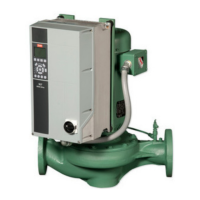Taco® SKV
6
302-365, Effective: June 5, 2017
© 2017 Taco, Inc.
7.3 VFD Mounting to Wall
7.3.1 Lifting
• Check the weight of the unit to determine a safe lift-
ing method.
• Ensure that the lifting device is suitable for the task.
• If necessary, plan for a hoist, crane, or forklift with the
appropriate rating to move the unit.
• For lifting, use hoist rings on the unit, when provided.
7.3.2 Mounting
• Mount the unit vertically.
• The frequency converter allows side by side installa-
tion.
• Ensure that the strength of the mounting location will
support the unit weight.
• Mount the unit to a solid flat surface or to the optional
back plate to provide cooling airflow (see Figure 7-2
and Figure 7-3).
• Improper mounting can result in overheating and
reduced performance.
• Use the slotted mounting holes on the unit for wall
mounting, when provided.
Figure 7-2: Proper Mounting with Back Plate
Item A is a back plate properly installed for required air-
flow to cool the unit.
Figure 7-3: Proper Mounting with Railings
NOTE: Back plate is required when mounted
on railings.
7.3.3 Tightening Torques
See “17.2 Connection Tightening Torques” on page 77
for proper tightening specifications.
7.4 Pump Piping – Detailed
In order to achieve the full added value of the Vertical In-
Line pump design, it is important that you ensure the
pump is affixed to the system piping by the pump flanges
and the pump and motor assembly is allowed to float
freely with the expansion and contraction of the piping
system. Should any vertical in-line pump use supports to
the structure, it is imperative that no pipe strain is
imposed on the pump flanges. Compliant mounts such
as springs or “waffle”-style isolation pads should be used
under the pipe supports if the pump is not truly pipe
mounted.
Various installation arrangements are detailed in the fig-
ures that follow.
Figure 7-4: Hanger Supported, Pipe Mounted
NOTE: The pump should not be rigidly attached to the base/pad structure unless flexible couplings are used.

